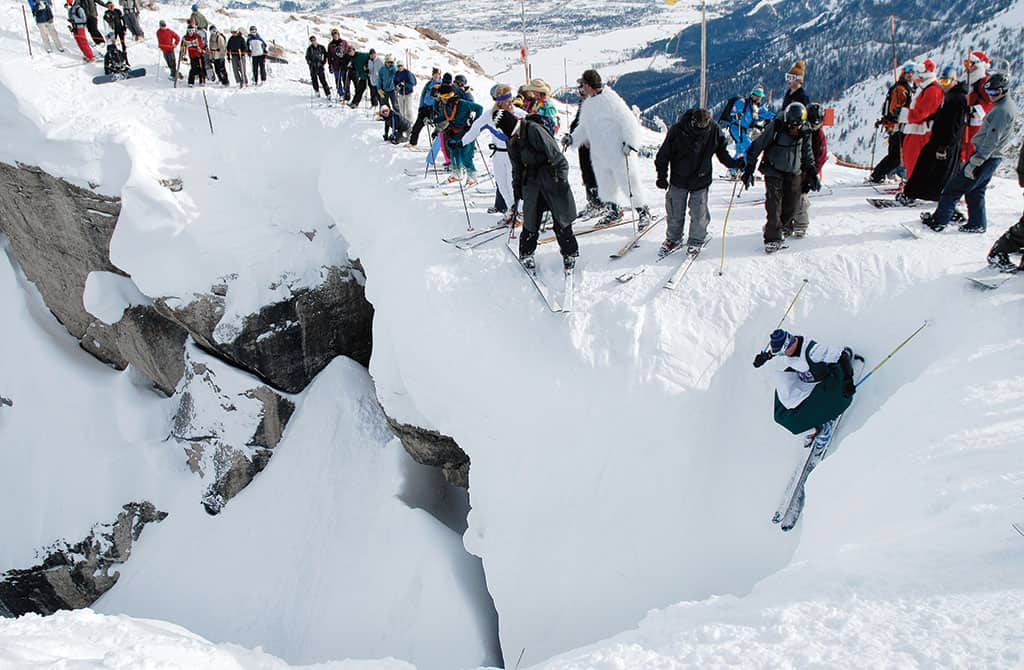Read The
Current Issue
Corbet’s Couloir
Ski it or see it, but don’t miss it
BY kelsey dayton

AFTER SHE MADE the decision to ski Corbet’s Couloir at Jackson Hole Mountain Resort, Morgan Kilmain knew she needed to follow one tip: “You don’t look at it for too long,” she says. “You just go for it. If you stare at it, you’ll get superscared and you’ll be like, ‘That’s too scary.’ ” Morgan was seven years old when she decided she was ready to ski Corbet’s—the run often called out in magazines like SKI and Skiing as the most difficult in the country. (She’s now eleven.)
The conditions were about as good as they could get for Morgan’s first time. It was a huge snow year, and some of the most imposing rocks along the run’s sides were covered. Also, there was enough snow at the entrance that she could ease her way in instead of doing the ten-foot jump usually required. Still, it was a fifty-some-degree slope she “eased” her way in to. Despite knowing better, it was impossible for Morgan not to pause at the top—but only for several seconds and some final coaching from her father, Bob, who skis the run about fifty times a season, sometimes showboating and entering with a flip. “You can do it. Trust your edges,” he told her. Then came the magic words he’d said to Morgan the first time she skied any new, intimidating run: “three, two, one, dropping.”
“Usually when he says that, I do it,” Morgan explains. And she did it at the top of Corbet’s, nailing the run. When she was seven years old.
Don’t let the fact that Morgan, at such a young age, successfully skied Corbet’s Couloir, known throughout the ski world simply as “Corbet’s,” fool you. The run is a test piece for North American skiers. If you’re an expert skier and tell a fellow skier you’ve skied Jackson, chances are the first question he or she will ask is, “Did you ski Corbet’s?” If your answer is “no,” chances are the conversation will veer back to last weekend’s game. If the answer is “yes,” chances are the asker will nod with approval and awe.
Rock walls guard the couloir. Whether you “ease” yourself in, as was possible in the huge winter of 2010-11, or have to take the straight-line plunge off the cornice at the top, once you are in, there’s no turning back. The entrance and first turn—if you don’t immediately make a hard right, you’ll smash into the western rock wall—are the toughest parts of the run. Make it past those and things get easy, relatively speaking: the fifty-some-degree pitch mellows out to forty-some degrees and the couloir widens. Often, its middle and bottom are choked with powder sloughed off above, a reward for making it that far.
CORBET’S COULOIR IS named after Barry Corbet, a Dartmouth grad (Class of ’58) who came to Jackson Hole and became one of the valley’s, and country’s, most accomplished ski and climbing guides. Corbet saw the narrow crease of snow surrounded by rock walls and prophesized, “Some day somebody will ski that.”
That somebody was Lonnie Ball, a nineteen-year-old ski patroller. He did it the second season the resort was open. Ball did not ski it on purpose but fell into it and, landing upright, figured he should just keep going. Since then people have done it on snowboards, telemark skis, and even monoskis. It’s been skied by someone wearing a costume that made them look like a slice of pizza.
“Corbet’s is one of those runs you can never truly master,” Bob Kilmain says. “It’s like a puzzle. It’s always different. There’s always a new line. There’s always a chance of everything going wrong and that does happen even to the best skiers in this town. That run will getcha. It’s not one you can be complacent about.” Kilmain himself has wrecked in spectacular fashion several times, with skis, poles, and gear flying everywhere. Locals call this type of fall a “yard sale.” If you wreck in Corbet’s there’s usually a yard sale involved, and it’s always viewed by several dozen people. The resort’s tram passes the run. There is a crowd at the top, some waiting to ski it themselves, but most are just there to spectate, and then there are spectators down in Tensleep Bowl, which the run opens into. “If you fall in Corbet’s, everyone knows about it,” says Tigger Knecht, who yard-saled magnificently his first time. One local skier recommends the resort put a webcam on the couloir: “People would watch it constantly.”




